 4
4

Examining the pyramid with the mions
 19. 04. 2024
19. 04. 2024



 4
4

 19. 04. 2024
19. 04. 2024

 1
1

 17. 04. 2024
17. 04. 2024
 6
6

 16. 04. 2024
16. 04. 2024
 11. 03. 2020
11. 03. 2020

Is Aztlan, the ancient homeland of a breathtaking Aztec civilization, real or is it just a mythical country described in legends? The Mexican Aztecs created one of the most important empires of ancient America. Although we know much about their empire in today's Mexico, little is known about their origins and origins. Many regard the lost island of Aztlan as the original homeland in which the Aztec civilization formed long before the Aztecs moved to the Valley of Mexico.
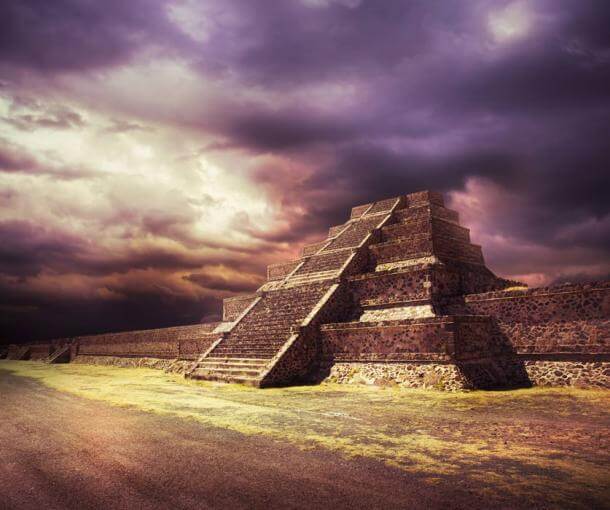
Illustration - photo composites of the Aztec Pyramid, not a real location.
Some people believe that it is a mythical country that will live forever in legends, but like Camelot or Atlantis, it will never be found. Others believe that this is a real place to be discovered once. In the hope of finding this legendary island, Aztlan is being searched for in a wide area from western Mexico to the Utah desert. However, these searches have so far been unsuccessful, and the place - and the very existence - of Aztlan remains a mystery.
The formation of civilization from Aztlan is based on legends. According to a nahuatl legend, there were originally seven tribes that once lived in Chicomoztoc - “the seven cave sites. ).
These seven groups, belonging to similar language groups, left their caves and settled as a monolithic group near Aztlan. According to some records, the arrival of seven groups to Aztlan preceded the arrival of a group known as the Chichimecs, who were considered less civilized than the seven Nahual tribes. The Mexicans were the last group to travel to Aztlan and could be slowed by a prolonged drought between 1100 and 1300 AD
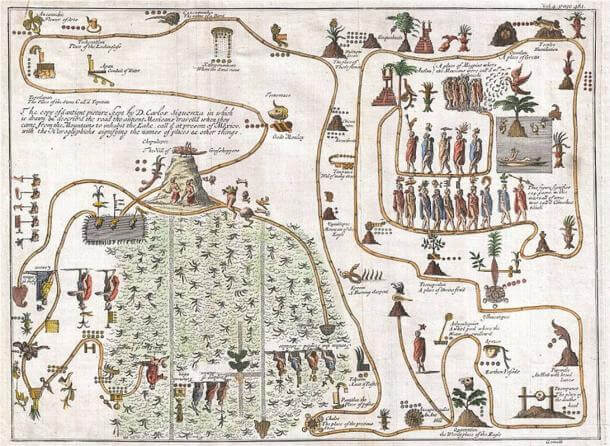
This rare map from 1704 drawn by Giovanni Francesco Gemelli Carerim is the first published representation of the legendary migration of the Aztecs of Aztlán, a mysterious paradise somewhere northwest of Mexico, into the highlands of Chapultepec, present-day Mexico City.
The word Aztlán means “land in the north; the country the Aztecs came from. ‟It is said that the people living in Aztlán eventually became Aztecs, who moved from there to the Valley of Mexico. In some stories, Aztlán has been described as a paradise on earth. In the Aubin Code, Aztlán was the place where the Aztecs were under the rule of Aztec Chicomoztoca - the cruelly ruling elite. To escape the Chicomozto, the Aztecs fled Aztlán under their priest. According to legend, the god Huitzilopochtli told them that they could use the name Aztec and be known as the Mexicans. The Aztec migration from Aztlán to Tenochtitlán is an important part of Aztec history. It began on May 24, 1064, the first solar year of the Aztec calendar.
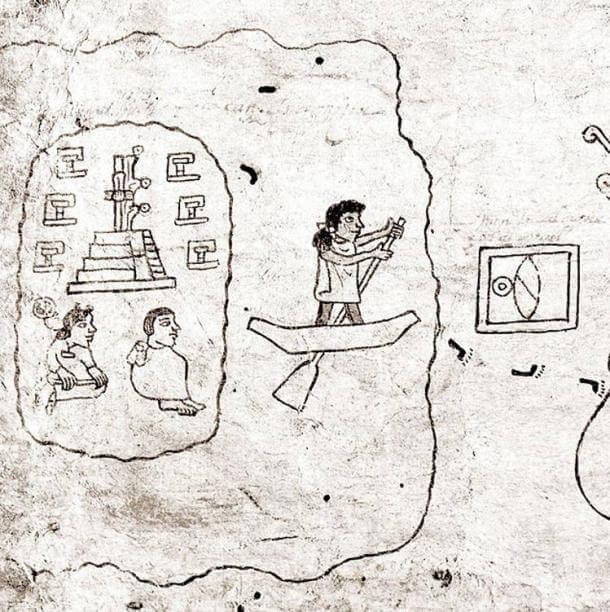
The Mexicans leave Aztlan. Drawing from Codex Boturini from the 16th century. created by an unknown Aztec author.
Although Aztlan has never been precisely localized, it is described as an island, but rather than a sea island, it was an island on a lake. Researchers have tried several times to identify a place that could be Aztlan, hoping to discover the place of origin of the Aztecs, later known as the Mexicans.
Some believe that the search for Atlantis and the search for Aztlan lead to the same goal because they are just different names of the same place. However, researchers cannot agree on this, and many believe that Aztlan is located elsewhere than the lost city of Atlantis.
One of the greatest mysteries surrounding Aztlan is how far north it could have been. The search for it reached Utah, and it is possible that the Aztecs did not come from Mexico at all, but their culture was formed in the territory of today's United States, from where they went to the Valley of Mexico. Some contemporary Mexican immigrants to the United States are trying to take this opportunity, claiming that they are only returning to their original homeland.
Many have tried to find Aztlan, but archaeologists do not believe that its possible discovery will provide a greater amount of remains of buildings or artifacts. Finding the Aztlan, however, will provide an insight into the history of the Aztecs and their place of origin, although there is consensus that the place of origin of the Aztecs is not so important, unlike their arrival in the Valley of Mexico and the events that followed.
When attempting to determine where Aztlán was, researchers encounter three methodological problems. The first is known as “enlargement.” It is likely that the Aztec civilization did not move directly from Aztlan to the Valley of Mexico because it would be too long a journey. Instead, they seem to have been zigzagging during their journey and settling repeatedly for various periods of time. It may be difficult to distinguish between a temporary destination and the full length of the journey.
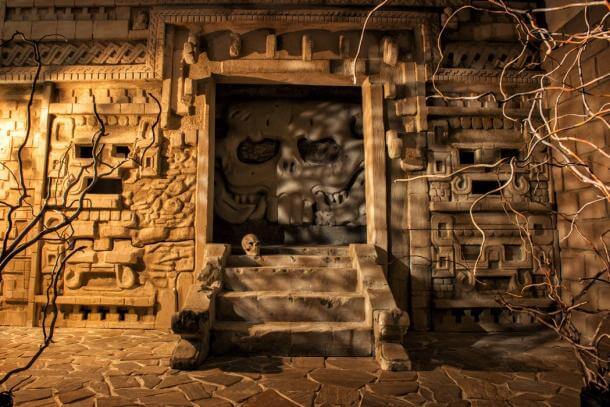
The play of light and shadow on an ancient temple creates a mystical impression. Will the legendary Aztlan ever be found?
The second problem is known as 'layering,' and points to the fact that probably more than one wave of north-south migration has occurred, and it is difficult to determine exactly which migration might have been the one from Aztlan.
The third problem is called "folding." The reason for this problem is that there may have been migration back and forth; from north to south and then back from south to north. These three methodological problems make it difficult to determine whether the Aztlan was the real place the Aztecs came from or whether it represented a symbolic place of origin in Aztec legends.
To date, the existence of the island known as Aztlán has not been confirmed. Those who decided to find him hoped that by finding it would contribute to a deeper understanding of the origin of the Aztecs and thus of the entire ancient history of Mexico. However, as with other mythical cities, it is unclear whether Aztlan will ever be discovered.
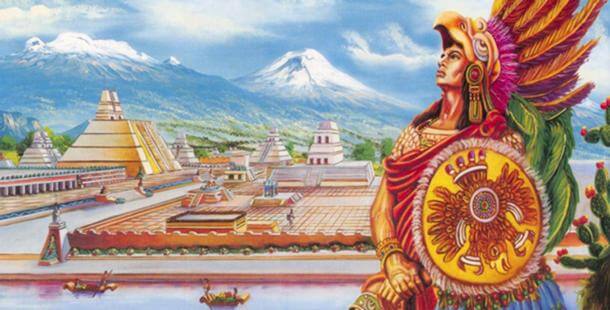
Illustration depicting Cauhtemoc, the last tlatoani, leader of the Aztecs.
Perhaps it was once an island that is now submerged under the surface of the lake, or somehow changed or destroyed. Perhaps it is a country that does not exist in the physical plane and is only found in the legends of the Aztecs. In the meantime, it remains a legendary place where a powerful Aztec civilization formed before moving to the area of today's Mexico City.
Classified facts and hidden discoveries from A to Z. Another book by well-known journalist Luce Bürgin documents such events as the finding of a pirate magnifying glass on Treasure Islandor the truth about Mona Lisa's paintings a Last dinner. It addresses many other issues that have been concealed or intentionally falsified and which are carefully documented in the publication, accompanied by compelling photographs.